Download PDF
Download page Bear Creek Reservoir - Inflow Record Extension.
Bear Creek Reservoir - Inflow Record Extension
Author
Katie Seefus, USACE Omaha District
Overview
This tutorial and guide explores four different record extension techniques for Bear Creek Reservoir, which is located near Denver, CO. A summary of the available Bear Creek Reservoir daily inflow gages is listed below. The drainage areas of each gage are shown in the following figure. The Bear Creek Reservoir calculated inflow includes the change in reservoir storage, the release, an evaporation estimate, and the Pioneer Union diversion. There is 21.4 sq. miles of local runoff between the two Morrison gages accounting for 9.1% of the total Bear Creek Reservoir drainage.
Inflow Gage | Record Length | Drainage (sq. miles) | Percent of Total Drainage |
|---|---|---|---|
Bear Creek Reservoir calculated inflow | July 1977 - current | 236 | 100% |
Bear Creek at Morrison (BCRMORCO/06710500) | May 1900 - Nov 1901; Oct 1919 - current | 164 | 69.5% |
Turkey Creek above Bear Creek Lake near Morrison (06711040) | May 1986 - Sep 1989; Mar 2019 - current | 50.6 | 21.4% |
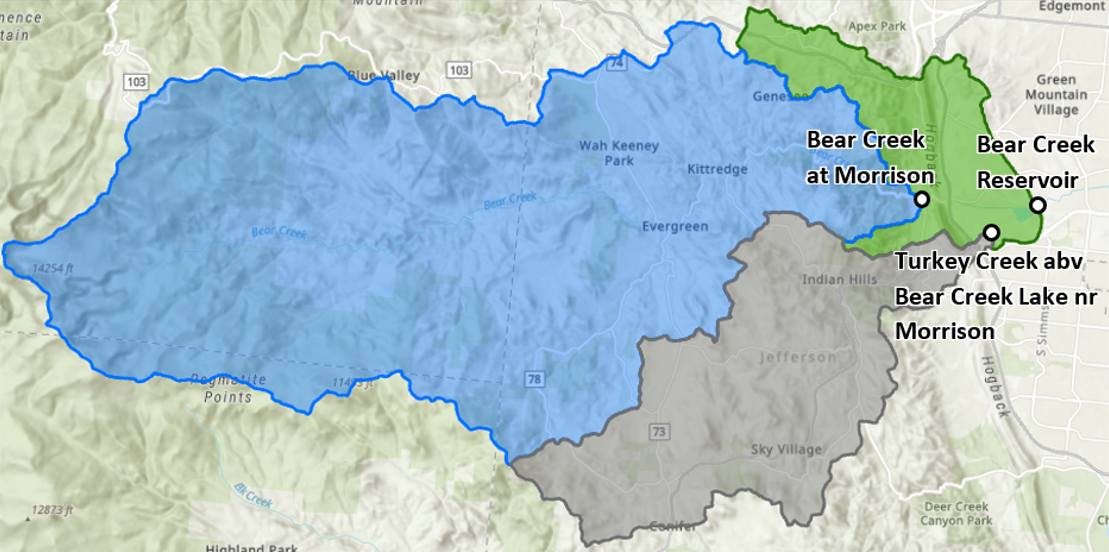
A typical storage-yield analysis will include running the period of record inflow with an assumption that the storage zone is full at the beginning of the record. After reviewing the Bear Creek Reservoir calculated inflow record, it was determined that 1977 and 1978 were fairly low inflow years. This meant that it may be a poor assumption that a new potential storage zone would be full at the beginning of the analysis and lead the team to determine if an inflow record extension could be performed. The Bear Creek at Morrison gage has a very lengthy flow record as seen in the above table. The team decided it would be important to extend the inflow record back to 1973 when a fairly large inflow event was experienced in the Bear Creek basin (see the figure below). This allows for the assumption of a full storage zone at the beginning of the record to be made.
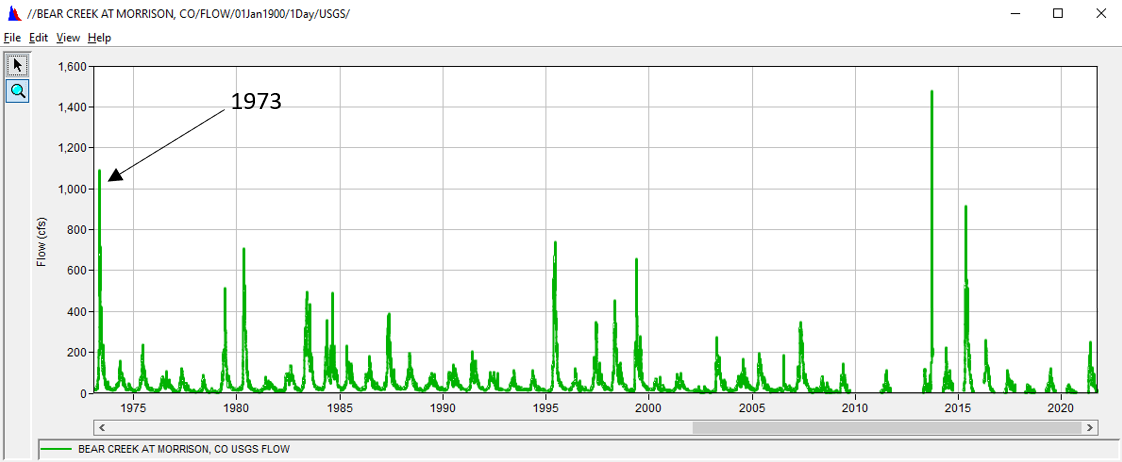
Computational Methods and Results
Because Turkey Creek accounts for 21.4% of the total drainage, it was decided that the analysis should consider including it in the Bear Creek Reservoir calculated inflow record extension. The following methods to extend the Bear Creek Reservoir calculated inflow were identified for further analysis:
- With HEC-SSP MOVE.1, use Bear Creek at Morrison to extend the Turkey Creek above Bear Creek Lake near Morrison then add the datasets to develop an extended inflow record.
- With HEC-SSP MOVE.1, only use Bear Creek at Morrison to extend the inflow record.
- With HEC-DSS, use the drainage ratio method.
- With HEC-DSS, perform a cyclic analysis to determine, on average, what percent of flow Turkey Creek contributes.
Method 1
The Turkey Creek above Bear Creek Lake near Morrison gage has a very limited data record of under seven years and the correlation between the Bear Creek at Morrison gage and the Turkey Creek gage is only 0.576. Despite the poor correlation as seen in the figure below, the HEC-SSP MOVE.1 data record extension results were performed by extending the Turkey Creek above Bear Creek Lake near Morrison with the Bear Creek at Morrison data (see the figure below). The MOVE.1 analysis included some sporadic missing data from 2011 through 2018 for the Turkey Creek above Bear Creek Lake near Morrison record. This missing data was linearly interpolated.
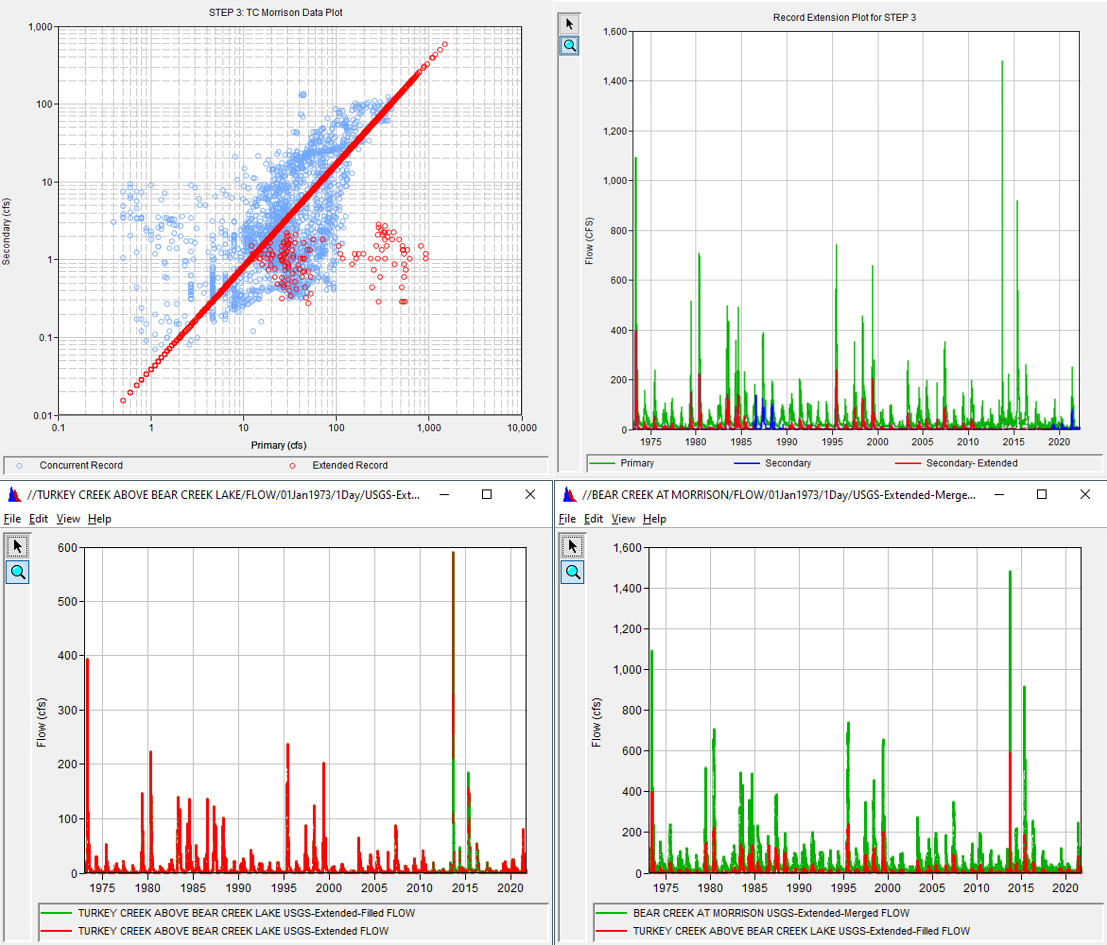
The extended and interpolated Turkey Creek above Bear Creek Lake near Morrison was then added to the Bear Creek at Morrison data and compared against the Bear Creek Reservoir calculated inflow as seen in the figure below.
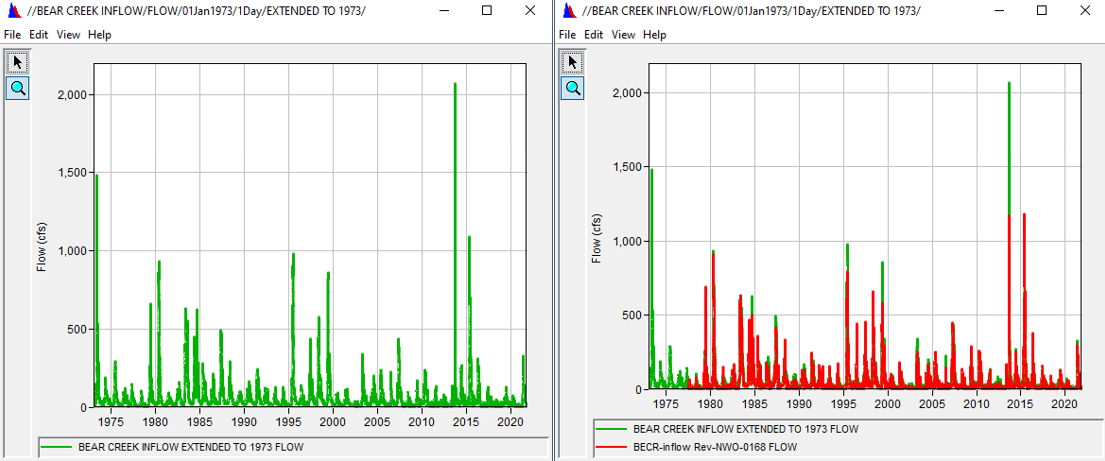
Most of the time the Bear Creek Reservoir calculated inflow volume by water year was smaller on average by nearly 7,500 ac-ft than the combined Bear Creek and Turkey Creek dataset, as shown below. This is likely due to the poor correlation.
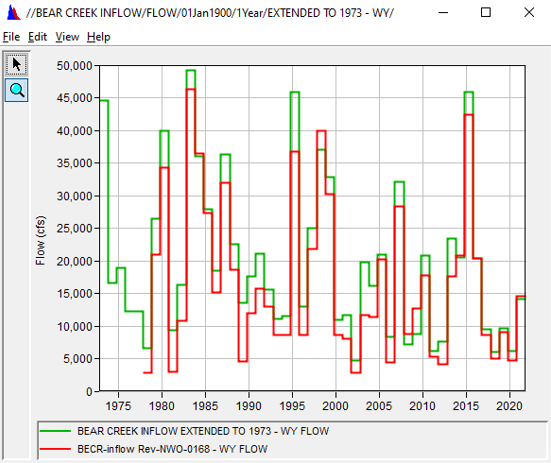
Method 2
The Bear Creek at Morrison gage has a very lengthy record and the correlation between the Bear Creek Reservoir calculated inflow and the Bear Creek at Morrison gage is 0.824, which is much better than the correlation in method 1, see Figure 6. The HEC-SSP MOVE.1 data record extension results were performed by extending the Bear Creek Reservoir calculated inflow with the Bear Creek at Morrison data (see the figure below).

When compared to method 1, this method resulted in a 61% larger peak flow estimate in 1973 and an 18% larger inflow volume in 1973 (see the figure below).
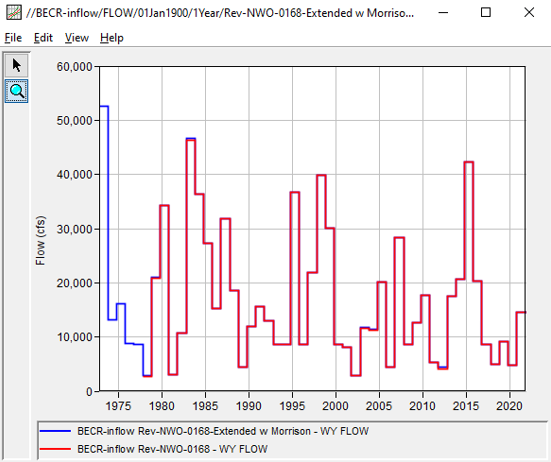
However, both methods produced very comparable inflow volumes from 1974 through 1977 (see figure below). Method 2 consisted of a smaller inflow volume and hydrograph for the 1974 through 1977 period.
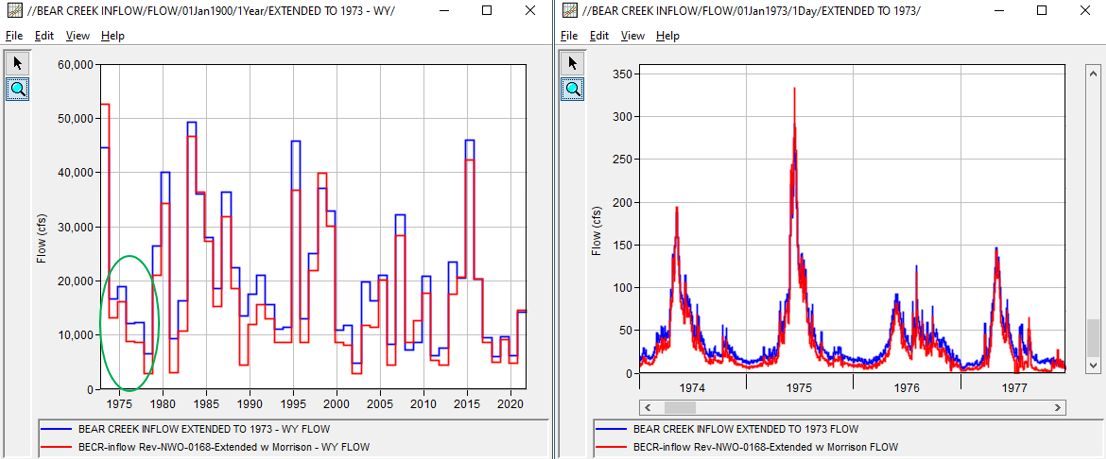
Method 3
The drainage ratio method (below equation) was applied to estimate the flow at the Turkey Creek above Bear Creek Lake near Morrison gage.
| Q_{1}=Q_{2}\left(\frac{A_{1}}{A_{2}}\right)^{b} |
where Q1 = Turkey Creek flow, Q2 = Bear Creek flow, A1 = Turkey Creek drainage, A2 = Bear Creek drainage, and b = regional exponent of drainage area. Based on a comparison between the estimate and the observed data, it was determined that a 1.0 regional exponent of drainage area was more representative than 0.5 (see figure below).
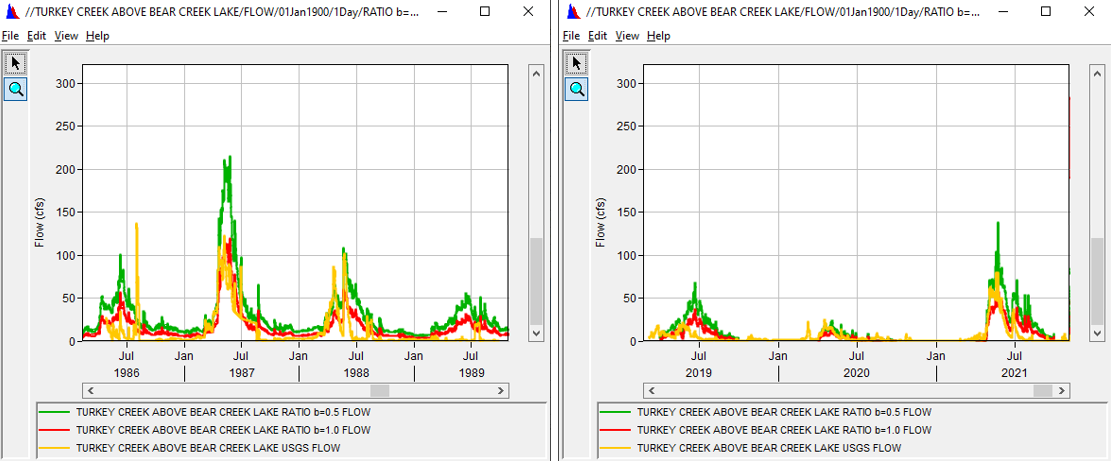
A 1.0 regional exponent of drainage area was used to estimate the Turkey Creek above Bear Creek Lake near Morrison flow and then added to the Bear Creek at Morrison flow to estimate the Bear Creek Reservoir inflow (see figure below).
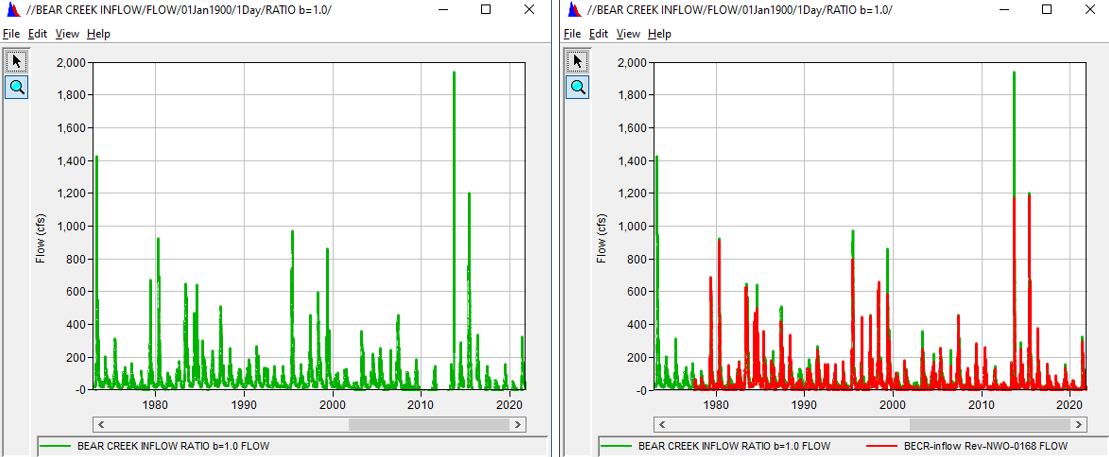
Method 4
A cyclic analysis was performed to determine if a daily average percent contribution from Turkey Creek could be determined. HEC-DSS was used to determine the daily average flow at the Bear Creek at Morrison and the Turkey Creek above Bear Creek Lake near Morrison gages. The results were then smoothed, and a smoothed daily average percent contribution was produced (see figure below).
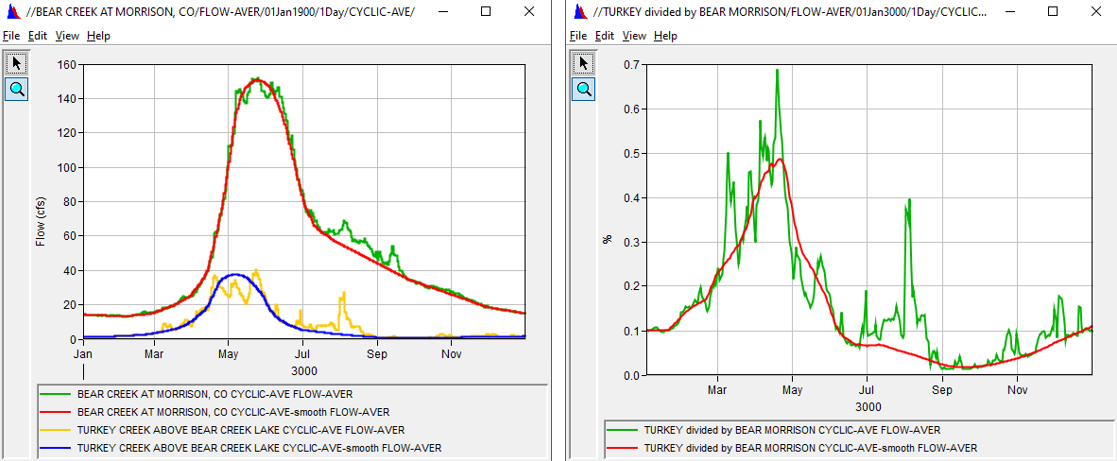
The percent pattern was then applied to the Bear Creek at Morrison gage to estimate the amount of flow Turkey Creek contributed. The estimated Turkey Creek flow was then added to the Bear Creek at Morrison flow to estimate the Bear Creek Reservoir inflow (see figure below).
